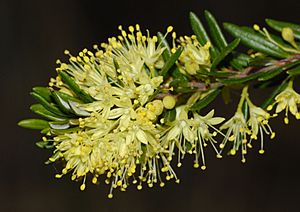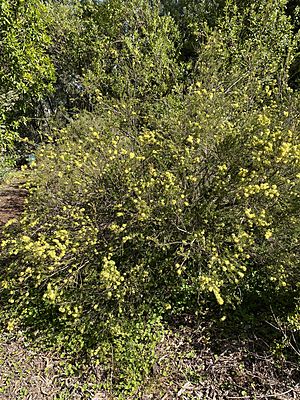Alpine phebalium facts for kids
Quick facts for kids Alpine phebalium |
|
|---|---|
 |
|
| Scientific classification | |
| Genus: |
Leionema
|
| Species: |
phylicifolium
|
| Synonyms | |
|
|
The alpine phebalium (scientific name: Leionema phylicifolium) is a special type of shrub that grows naturally in south-eastern Australia. It's a small plant with smooth, green, leathery leaves. In springtime, it shows off beautiful pale yellow flowers.
What it Looks Like
The alpine phebalium is a small, bushy plant. It can grow up to about 1.5 meters (about 5 feet) tall. Its branches are somewhat needle-shaped and have soft, star-like hairs.
Leaves
The leaves of this plant are tough and feel like leather. They are usually oblong or narrow with edges that curl slightly downwards. Each leaf is about 8 to 17 millimeters long (less than an inch) and 1.5 to 2.5 millimeters wide. They have smooth edges.
Flowers
The flowers grow in small groups, usually 3 or 4 together. These groups form a cylinder shape at the end of the branches or in the leaf corners. Each flower cluster sits on a small stalk called a peduncle, which can be up to 4 millimeters long.
The individual flowers are on a short, fleshy stalk called a pedicel, about 1 to 3 millimeters long. Tiny, egg-shaped leaves called bracts are found near the flowers. The outer parts of the flower, called the calyx lobes, are smooth and triangular.
The petals are narrow and spread out, measuring about 3.5 to 4 millimeters long. They are a pale yellow color. The stamens (the parts that produce pollen) are a little longer than the petals.
Fruit
After the flowers, the plant produces a dry fruit. This fruit is about 3 millimeters long and has a small beak-like tip. It might have a few hairs on it.
How it Got its Name
The alpine phebalium was first officially described by a botanist named Ferdinand von Mueller. He was a government botanist in Victoria, Australia. He found this plant on the highest peaks of the Cobboras Mountains and near where the Mitta Mitta River starts.
Mueller first named it Phebalium phylicifolium. He wrote about it in a science publication called Transactions and Proceedings of the Victorian Institute for the Advancement of Science. Later, in 1998, another scientist named Paul G. Wilson changed its name to Leionema phylicifolium. This new name was published in a journal called Nuytsia.
Where it Grows
You can find the alpine phebalium growing in high places in eastern Victoria. It likes areas with scrubland, eucalypt woodlands, and heath, especially where it's wetter.
It also grows in the very south-east part of New South Wales. Here, it's found in Kosciuszko National Park and south of the upper Tuross River. In these areas, it grows in dry sclerophyll forests and heathlands.



